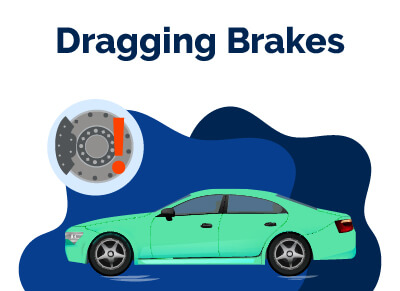Dragging Brakes (Effects, Causes, and Fixes)
July 23, 2023


Chris is Head of Content for FindTheBestCarPrice and is based out of Philadelphia, PA. As a seasoned automotive industry analyst and car enthusiast, he ensures the highest level of quality across all our content and curates our picks for the best deals each month.
Chris studied information systems and marketing at Drexel University and writes about a wide range of topics ranging from car buying tips to troubleshooting common mechanical issues.
When he’s not thinking about cars, he likes to stay in with his dog and make an “attempt” to finish a crossword puzzle (he’s not quite at the Saturday/Sunday level…yet). As a former cheesemonger, Chris still has a “sharp” passion for all things cheese, and his fridge is always loaded with it!
Chris also has a passion for things that go fast, and drones are no exception. He spends some of his time writing for Dronesourced.
An automobile depends on its braking mechanism for secure and proficient halting, regardless of whether it is cruising at highway velocities or merely reversing out of the driveway.
Alas, overuse may cause your braking system to encounter issues eventually. Such difficulties can jeopardize both your and your car's safety. That said, one of the most commonly occurring braking malfunctions is known as brake drag.
Dragging brakes arise when one or more brakes fail to disengage completely upon releasing the pedal. This can result from a range of fundamental mechanical problems.
Let’s look at the usual causes of dragging brakes, how to reduce it, and many more.
Let’s get started!
Table of Contents
Dragging Brake Causes
The following are the leading causes of brake drag:
1. When the Length of the Push Rod Is Excessive
The brake system in your vehicle encompasses several elements, each with a unique function in braking. Among the initial components to engage is the push rod, which connects to your brake pedal and transfers force from your foot to the brakes.
To be more precise, depressing the pedal causes the push rod to transmit force to the master cylinder, which dispenses the hydraulic fluid crucial for braking.
The length of the push rod is crucial in providing precise and responsive outcomes. If it's too short, the brakes won't activate quickly enough.
Conversely, an excessively long push rod causes brake drag. The excessive length prevents the master cylinder from releasing entirely when you let go of the brakes.
Thus, the hydraulic force continues to act on your brakes, keeping them pressed against the rotors on your wheels.
The push rod should have a negligible amount of free play. A small space between the push rod and the master cylinder prevents brake drag while sidestepping unresponsive brakes.
An auto mechanic can gauge the exact amount of play before your brake activates and make the necessary adjustments.
2. Caliper Misalignment
Proper caliper alignment concerning the rotor is crucial to prevent brake drag. Over time, a caliper may lose its alignment, leading to one of the brake pads continuously touching the rotor's surface.
Several factors can contribute to caliper misalignment, such as a collision that bends the mounting brackets that secure the caliper in position. Additionally, excessively warped rotors or pads due to overheating can cause misalignment.
An adept mechanic can swiftly detect a misaligned caliper by inspecting your brakes visually.
They may also use a specialized tool to gauge the space between each brake pad and the rotor. Utilizing this data, the technician can adjust the caliper's centering to ensure precise outcomes.
3. Defective Caliper Piston
During braking, your brake pads contact the wheel rotors, generating friction that reduces your car's speed.
The brake pads attach to the brake caliper, which, in turn, moves them against the rotor when you step on the brake pedal.
Calipers operate by closing and releasing in response to the flow of hydraulic fluid. Each of the four calipers on your wheels features a dedicated piston that transfers hydraulic force into the mechanical movement of the caliper.
However, if a caliper piston develops issues, it may no longer control caliper movement accurately, causing hydraulic fluid to leak around the damaged piston.
The caliper fails to release when you take your foot off the brake pedal. Unlike other causes of brake drag, a faulty caliper piston only affects one wheel.
4. Incorrect Wheel Bearing Installation
This scenario may seem like brake drag, but it is caused by seized wheel bearings due to insufficient grease or excessive tightening during installation.
The most straightforward method to identify this issue is to remove the caliper from the rotor and spin the rotor. If the drag persists, the bearings are likely the problem.
In that case, replace them as needed and reinstall them with the correct torque value and pre-load.
5. Heat (Hydraulic Brake Drag)
Heat can induce brake drag in various ways, but the most prevalent case is caused by the brake fluid surpassing its boiling point. Ensuring sufficient clearance between the brake lines and the exhaust is essential.
Additionally, depending on the placement of the master cylinder or booster/master, confirming adequate space between those parts and the engine or exhaust is crucial.
To resolve this issue, the components in the system should be shielded as needed, and the brake fluid should be replaced with a high-quality alternative.
How To Reduce Brake Dragging
Brake dragging is a condition that transpires when the brake pads continue to come in contact with the rotor, even after the brake pedal has been released.
This issue can prove risky, as it can result in excessive heating of the braking system, diminished fuel efficiency, and even complete brake malfunction.
Fortunately, there are numerous approaches to mitigate brake dragging and ensure that the braking system functions correctly and safely.
The first step to minimizing brake dragging is to guarantee that the braking system functions optimally. Routine upkeep (brake evaluations and substituting worn brake pads and rotors) can help prevent brake dragging from happening.
It is also imperative to use high-quality brake pads and fluid, as inferior products can heighten the probability of brake dragging.
Another element that may contribute to brake dragging is the alignment of the brake calipers.
The calipers are accountable for moving the brake pads against the rotor, and if they become misaligned, the brake pads may not wholly disengage from the rotor when the pedal is released.
A qualified mechanic should inspect and adjust the calipers to resolve this predicament, ensuring they are correctly aligned.
Heat is yet another leading cause of brake dragging. When brake fluid attains and surpasses its boiling point, it can cause the brake pads to adhere to the rotor.
To reduce the risk of this occurring, it is vital to have sufficient clearance between the brake lines and exhaust and to guarantee adequate space between the master cylinder or booster/master and the engine or exhaust.
Shielding the components in the system as required and replacing the brake fluid with superior-quality brake fluid can also help minimize the risk of heat-induced brake dragging.
The Effects of Brake Drag
One of the most significant effects of brake drag is a reduction in fuel efficiency. The constant contact between the brake pads and rotor creates substantial friction, necessitating more energy to move the vehicle forward.
This decreases fuel economy, causing the operator to spend more money on gasoline over time.
Besides a decrease in fuel efficiency, brake drag can also result in overheating of the braking system. The constant friction generated by the brake pads and rotor can cause excessive heat accumulation, leading to warping or even cracking of the rotors.
This not only reduces the effectiveness of the brakes but also necessitates costly repairs or replacements.
Brake drag can also lead to uneven brake pad wear, necessitating more frequent replacements.
When the brake pads remain in contact with the rotor, even when not in use, the pads can wear down more quickly, leading to a shorter lifespan and the need for more frequent replacements.
Moreover, brake drag can pose a significant safety hazard. The excessive heat generated by the dragging brakes can cause the brake fluid to boil, leading to complete brake failure.
This can be particularly dangerous in emergencies where quick, responsive braking is essential. It is vital to address brake drag promptly to prevent damage to the vehicle, avoid costly repairs, and ensure safe and effective braking.
Best Car Deals by Category
Frequently Asked Questions
Is brake drag dangerous?
Yes, brake drag can be a severe safety concern. It can lead to overheating of the braking system, decreased effectiveness of the brakes, and even complete brake failure.
This can be particularly dangerous in emergencies where quick, responsive braking is essential.
Can I fix the brake drag myself?
While a skilled DIYer can address some minor brake issues, fixing brake drag typically requires the expertise of a trained mechanic.
Attempting to fix brake drag without proper knowledge and tools can lead to further damage or even create new safety hazards.
How can I prevent brake drag?
Regular maintenance (brake inspections and replacing worn brake components) can help prevent brake drag from occurring.
It is also essential to use high-quality brake pads and fluid to ensure that the brake system components are correctly aligned and have adequate clearance.
How much does it cost to fix brake drag?
The cost to fix brake drag can vary depending on the specific issue and the extent of the damage. It may require something as simple as a brake adjustment or more extensive repairs, such as replacing damaged components.
It is best to have a trained mechanic inspect the brakes to provide an accurate estimate of the cost of fixing the issue.
Posted in Car Buying Tips, Car Troubleshooting |




